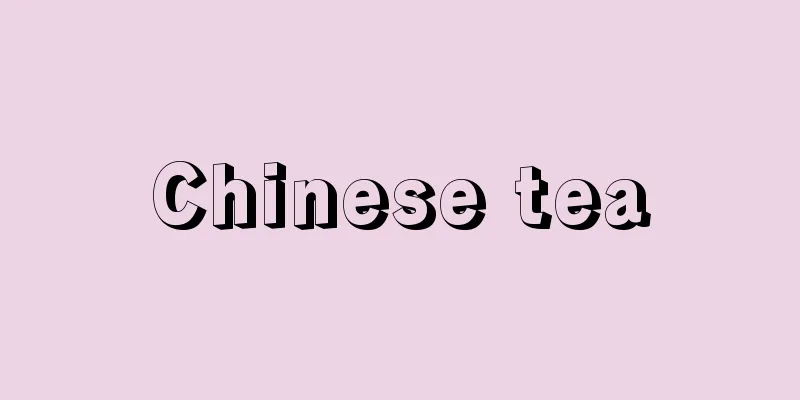Chinese tea

|
Tea produced in China. Drinking, cultivating, and manufacturing of tea all began in China. According to the Shennong Bencao Jing (around the time of Christ), tea was first used for medicinal purposes. The Erya (Western Han) also reveals that tea drinking began as early as the Spring and Autumn Period and Warring States Period. During the Western Han Period, tea was sold in Sichuan, and there is a record of tea being boiled and drunk (Daoyaku). During the Three Kingdoms Period, the custom of drinking tea spread throughout the Jiangnan region. By the Tang Dynasty, tea drinking had become common throughout the country, including the northeast, and tea trees were cultivated in various parts of the south. Against this backdrop, the world's first full-scale tea book, the Cha Jing (around 760), was written by Lu Yu. Until the Song and Yuan dynasties, the upper classes seemed to drink mostly solid teas such as pincha (rice cake), but in the Ming dynasty, sencha (green tea), which is made by pouring hot water over tea leaves, became mainstream. Chinese tea was exported to Europe via the Netherlands in the early 17th century, and it dominated the world tea market until the 1870s, when Assam black tea was produced in large quantities. However, after the Opium Wars, which were the indirect cause of the large-scale export of Chinese tea to Britain, the position of Chinese tea shifted to black tea produced in India and Sri Lanka (Ceylon). Until the mid-20th century, Chinese tea production was in a steady decline, and in 1949, production fell to 40,000 tons, and Chinese tea exports, which once recorded 134,000 tons, plummeted to just under 8,000 tons. However, after the founding of the People's Republic of China, efforts were made to promote tea production, such as expanding the northern limit of tea cultivation, under the slogan "Bring tea from the south to the north." In 1976, annual production reached a new record for the first time in 90 years. Production has continued to grow steadily since, reaching 456,000 tons in 1985, 562,000 tons in 1990, 609,000 tons in 1995, 704,000 tons in 2000, and 721,000 tons in 2001. China's tea production accounts for approximately one-fifth of the world's total tea production, making it the second largest after India. In 2001, the area cultivated with tea was 899,000 hectares, accounting for approximately 40% of the world's total tea cultivation area. [Yoshihiro Hamaguchi] Type and manufacturing methodAs stated at the beginning of the Cha Jing, "Tea plants are the virtuous trees of the south," they grow in southern China, but their original habitat is unclear. Judging from the large variation in botanical characteristics, it is presumed to have originated in the mountainous region on the borders of the provinces of Sichuan, Guizhou, and Yunnan, namely from the Hengduan Mountains to the Dalo Mountains. Currently, tea is cultivated in 17 provinces, excluding the northeast, Inner Mongolia, and northwest, and is found in the northernmost region of Penglai, Shandong Province, the southernmost region of Hainan Island, Taiwan in the east, and Chayu in Tibet in the west. The types of tea plants are extremely diverse and have a wide range of variations, befitting their place of origin. They range from shrubs one or two meters tall to tall trees up to 30 meters tall. Based on the size of the leaves, there are "large-leaf" and "small-leaf" varieties, and also on their shapes, there are "melon," "loquat," "Buddha's hand," "bamboo-leaf," and "willow-leaf" varieties. Furthermore, there are large differences in the color of the buds and the time they germinate, and there are over 100 major varieties. The main tea-producing areas in China are Zhejiang, Hunan, Anhui, and Sichuan. These four provinces account for 65% of the country's tea, followed by the three provinces of Fujian, Hubei, and Yunnan, which account for 20%. Chinese tea has its own characteristics and personality based on the natural conditions of the producing area and the cultural traditions of the region, and it maintains its non-uniform taste and aroma even today as a famous regional tea. Regarding tea production, it is customary to divide tea into six major types based on the manufacturing process: [1] Black tea: It is fully fermented and processed into tea. It is mainly exported, accounting for about 20% of all Chinese tea. It is further divided into three categories. (1) Kongfu black tea: Made using traditional Chinese methods, it has a well-balanced appearance, is dark in color, and when brewed has a vivid red color and a unique fragrance. The most famous are Qihong from Qimen, Anhui, and Dianhong from Yunnan. (2) Xiaozhong black tea: The leaves are thick and chunky. Zhengshan Xiaozhong from Chong'an, Fujian is the most famous. (3) Graded Black Tea: These come in a range of types, from loose leaf to powdered tea, with the large-leaf red broken tea from Yunnan, Guangdong and Guangxi being the highest quality. [2] Green tea is a non-fermented tea. It is made by killing green tea and then heating the leaves to prevent oxidation. It has the longest history among Chinese teas, and even today it accounts for more than 40% of all Chinese teas. It is further divided into four categories. (1) Chaoqing: Roast in a kettle. Thin-brow teas include Anhui Tunxi green tea, Zhejiang Shaoxing Pingshui Zhu tea, and especially West Lake Longjing tea. Other famous teas include Dongting Biluochun, Lushan Yunwu, and Duyun Maojian. (2) Hongqing: Fresh leaves are roasted over charcoal and dried. Liuan cucumber pian is a famous example. (3) Chaiqing: Exposed to sunlight and then roasted. Examples include Shaanqing from Ziyang, Shaanxi. (4) Chongqing: Steamed with water. Examples include Gyokuro from Enshi in Hubei. [3] Oolong tea: Semi-fermented tea that is said to have the best qualities of both green and black tea. It is not produced in large quantities. Fujian's Wuyi Rock Tea, Anxi Iron Guanyin Tea, and Shuixian Tea are well-known. [4] White tea (Pai Cha) This is unfermented, unrolled tea, and is made from young leaves that are rich in tannins. Fujian's Baihao Yinzhen is a representative example. Others include Bai Mudan and Shoumei. It is a rare tea. [5] Flower tea (Hua Cha) This is made mainly from Hongqing green tea and has a floral scent. It accounts for about 6% of all Chinese tea. Those named after the flower include Molihuacha (Jasmine tea) and Yulanhuacha (White magnolia tea), and those named after the raw tea include Huahongqing (Hua Hongqing) and Hua Maofeng (Hua Maofeng). [6] Compressed tea (Chinyacha) - Various types of tea leaves are steamed and then compressed to form a solid. It comes in various shapes, including brick-shaped ones like brick tea. It is sold to border areas such as Tibet and Mongolia, and accounts for one-quarter of the total tea production. In addition, tea can be divided into six types: black tea, green tea, blue tea, dark tea, white tea, and yellow tea. Blue tea corresponds to oolong tea in [3], and dark tea includes Pu-erh tea as well as some of the compressed teas in [6] that are post-fermented. Yellow tea is closer to green tea and includes Sichuan Mengding Yellow Meat and Hunan Junshan Yinzhen. [Yoshihiro Hamaguchi] How to drinkIn China, flower tea is said to be preferred in the north and green tea in the south, with ethnic minorities fond of brick tea. The usual way to drink flower tea or green tea is to put the tea leaves directly into a tall teacup with a lid and handle, and pour hot water over it. In Fujian and other areas, oolong tea is sometimes put into a small teapot and drunk from a small cup-shaped teacup. In Tibet and Mongolia, pressed tea is boiled and then drunk with sheep's milk and salt added. In China, a wide variety of teas are drunk in a variety of ways, depending on the lifestyles and customs of each region across the vast country. [Yoshihiro Hamaguchi] [References] | | | | |Source: Shogakukan Encyclopedia Nipponica About Encyclopedia Nipponica Information | Legend |
|
中国で生産される茶。茶の飲用、栽培、製造は、すべて中国で始まった。『神農本草経(しんのうほんぞうきょう)』(西暦紀元前後)によれば、茶は初めは薬用に用いられていた。また古く春秋戦国時代に飲茶が始まったことは『爾雅(じが)』(前漢)からうかがえる。前漢時代には、四川(しせん/スーチョワン)で茶が売られており、茶を煮て飲んだ記録(『僮約(どうやく)』)がある。三国時代には、飲茶の習慣は江南一帯に広がった。唐代に至ると、飲茶は東北を含め全国でみられるようになり、茶樹の栽培も南方各地で行われた。それを背景に、世界で最初の本格的な茶書である陸羽(りくう)の『茶経(ちゃきょう)』(760ころ)が書かれた。宋(そう)、元(げん)代までは少なくとも上流階級で愛飲されたものは、餅茶(ピンチャー)などの固形茶が中心であったとみられるが、明(みん)代になると茶葉に湯を注いで飲む煎茶(せんちゃ)が主流となった。中国茶は17世紀初めオランダを介してヨーロッパに輸出されてから、以後1870年代にアッサム種の紅茶が多量に生産されるまで、世界の茶の市場で独占的位置を占めた。だが中国茶のイギリスへの多量輸出に遠因をもつアヘン戦争を境として、中国茶の位置は、このインド、スリランカ(セイロン)産の紅茶に変わっていった。20世紀中葉まで、中国茶の生産は低下の一途をたどり、1949年には、その生産量は4万トンに下がり、かつて13.4万トンを記録したこともある中国茶の輸出量もわずか8000トン足らずまで激減した。しかし、新中国建国後は「南茶北引」をスローガンに、茶の北限を拡大するなど茶生産の振興が図られてきた。1976年は90年ぶりに年間生産量を更新した。その後も順調に生産量は伸び続け、85年45.6万トン、90年56.2万トン、95年60.9万トン、2000年70.4万トン、2001年72.1万トンとなっている。中国茶の生産量は、世界の茶の総生産の約5分の1であり、インドに次いで第2位を占める。なお2001年の栽培面積は89万9000ヘクタールで、世界の総栽培面積の約40%を占めている。 [浜口義曠] 種類・製法茶樹は、『茶経』冒頭の「南方之嘉木(かぼく)也」という記述のとおり、中国南部に生育したものであるが、その原生地については明確ではない。植物学的特徴の変異の大きさからみて、中国の四川、貴州、雲南各省の境界の山地、すなわち横断(ホントワン)山脈から大婁(ターロウ)山脈に至ると推定されている。現在、栽培されている地域は、東北部、内蒙古(うちもうこ)、西北部を除く17省などであり、北限は山東省蓬莱(ポンライ)、南限は海南(ハイナン)島であり、東は台湾、西はチベット察隅(チヤーユイ)にわたる。茶樹の種類は、原産地にふさわしくきわめて多様で偏差に富む。1、2メートルの低木から30メートルの高木まである。葉の大きさから「大葉種」と「小葉種」があり、その形状も「瓜(うり)種」「びわ種」「仏手種」「竹葉種」「柳葉種」がある。さらに芽の色、発芽時期に大きな差があり、おもな品種でも100余種になる。中国茶のおもな生産地は、浙江(せっこう/チョーチヤン)、湖南、安徽(あんき/アンホイ)、四川である。この4省で全国の65%を占める。ついで福建、湖北、雲南の3省で20%を占める。中国茶の場合、生産地の自然条件や地域の文化の伝統に基づいて、特性、性格をもっており、地方の名茶として今日も画一的でない味と香りを維持している。 製茶については、その製造工程から次のような六大茶類に分けるのを通例とする。 〔1〕紅茶 完全に発酵させて製茶する。主として輸出品で、中国茶全体の2割程度を占める。さらに3分類する。 (1)工夫(コンフー)紅茶 中国の伝統的な製法によりつくられたもので、外観が均整がとれ、色黒く、いれた水色は鮮やかな紅色で特有の芳香がある。安徽祁門(チーメン)の祁紅(チーホン)、雲南の滇紅(ティエンホン)が著名。 (2)小種紅茶 葉が厚く、形状は太い。福建崇安(すうあん/チョンアン)の正山(チョンシャン)小種が有名。 (3)分級紅茶 葉状のものから粉末茶まであり、雲南、広東、広西の大葉種の紅砕茶が最高級品。 〔2〕緑茶 不発酵茶である。殺青(さっせい)→加熱処理を経て、生葉の酸化を抑え製茶する。中国茶のなかでもっとも古い歴史をもち、今日でも中国茶全体の40%余を占める。さらに4分類する。 (1)炒青(チャオチン) 釜(かま)等で煎(い)る。細い眉茶(まゆちゃ)では安徽屯渓(トウンシー)緑茶、珠状の浙江紹興(シャオシン)の平水珠茶(ピンシュイチューチャー)があり、西湖竜井(ロンチン)はとくに有名である。このほか洞庭碧螺春(ピールオチュン)、盧山雲霧(ルーシャンユンウー)、都勻毛尖(トウーユンマオチエン)も名茶である。 (2)烘青(ホンチン) 生葉を炭火であぶり乾燥させる。六安瓜片(リューアンクアピエン)が有名。 (3)晒青(チャイチン) 日光にさらしたのちあぶる。陝西紫陽(ツーヤン)の陝青(シヤンチン)などがある。 (4)蒸青(チョンチン) 水蒸気で蒸す。湖北恩施(エンシー)の玉露などがある。 〔3〕烏竜茶(ウーロンチャー) 半発酵茶で、緑茶と紅茶のよさをあわせもつといわれる。生産量はかならずしも多くない。福建の武夷岩茶(ウーイーイエンチャー)、安渓鉄観音(アンシーテイェクワンイン)、水仙(シュイシエン)が著名。 〔4〕白茶(パイチャー) 不発酵、不揉捻(ふじゅうねん)の茶で、タンニンの多い若芽を原料とする。福建の白毫銀針(パイハオインチェン)が代表。ほかに白牡丹(パイムータン)や寿眉(ショウメイ)がある。茶の珍品である。 〔5〕花茶(ホワチャー) おもに烘青緑茶を原料に花の香りをつけたもの。中国茶全体の6%程度を占める。花の名でよばれるものに、茉莉花茶(モーリホワチャー)(ジャスミン茶)、玉蘭花茶(ユイランホワチャー)(白モクレン茶)などがあり、原料茶の名でよばれるものに花烘青(ホアホンチン)、花毛峰(ホワマオフォン)などがある。 〔6〕緊圧茶(チンヤーチャー)(磚茶(たんちゃ)) 各種の茶葉を蒸したのち、圧縮して固めたもの。磚茶のようにれんが状のものなどさまざまな形のものがある。チベット、モンゴルなど辺境の地へ売り、茶の総生産量の4分の1に達する。 ほかに、紅茶、緑茶、青茶、黒茶、白茶、黄茶の6種類に分けることもある。青茶は〔3〕の烏竜茶にあたり、黒茶は普洱茶(プーアルチャー)のほか後発酵茶で〔6〕の緊圧茶の一部を含む。黄茶は緑茶に近く、四川蒙頂(モンティン)黄芽や湖南君山銀針(チュンシャンインチェン)などがある。 [浜口義曠] 飲み方中国では、北方では花茶が、南方では緑茶が好まれるといわれ、少数民族は磚茶を愛飲している。花茶や緑茶は、蓋(ふた)付きで持ち手のついた丈の高い茶碗(ちゃわん)に直接茶葉を入れ、熱湯を注いで飲むのが普通の飲み方である。烏竜茶については福建などでは、小さな急須(きゅうす)に葉を入れ、小さな杯(さかずき)状の湯飲みで飲むこともある。チベットやモンゴルでは緊圧茶を煮たうえに、ヒツジの乳や塩を加えて飲む。中国では、広い国土の各地の生活習慣により、さまざまな方法で多様な茶が飲まれている。 [浜口義曠] [参照項目] | | | | |出典 小学館 日本大百科全書(ニッポニカ)日本大百科全書(ニッポニカ)について 情報 | 凡例 |
>>: Chugoku region - Chugoku region
Recommend
Miyakoji Bungojo - Miyakoji Bungojo
He was a joruri tayu (a chanter) and the founder ...
Chancelade man
This late Paleolithic human bone was excavated in...
Yuzhnyi Bug (English notation) YuzhnyiBug
…A river in southern Ukraine. Also known as the Y...
Aigou - Aigou
A Chinese custom that refers to crying loudly in ...
Ikoma clan
He was the lord of Yashima Domain in Dewa Provinc...
Saganoseki Peninsula
A wedge-shaped peninsula in eastern Oita Prefectu...
Chu-xue-ji (English: First Study Record)
A Chinese treatise. Compiled by Xu Jian and others...
Abruzzi and Molise [province] - Abruzzi and Molise
...area: 4,438 km2, population: 330,000 (1994). I...
Laying on of hands - Anshuurei
In the Christian church, a ritual of consecration ...
Wittig, G. (English spelling) WittigG
…A reaction that uses an ylide of a phosphorus co...
International division of labor
Taking advantage of the production aptitudes that...
Iyunks (car) - Iyunks
...As for things related to the heavens and the s...
Dibenzoyl Peroxide - Casanca Dibenzoyl
C 14 H 10 O 4 (242.22). Abbreviated as BPO. Also ...
Oanhanzeirei - Oanhanzeirei
...During the Kenmu Restoration after the fall of...
Geranium carolinianum (English spelling)
…[Mitsuko Shimizu]. … *Some of the terminology th...









